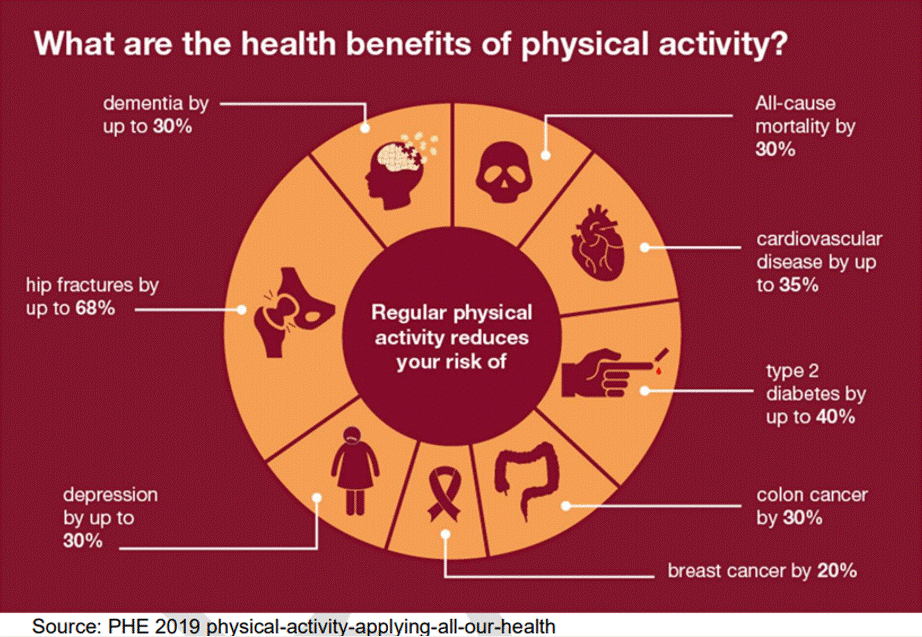Why do we need LTNs?
Health benefits of walking and cycling
Did you know that…
- 18% of journeys under 1 mile are made by car
- 57% of car journeys are under 5 miles? [5]
So why is this the case?
There are lots of reasons why our neighbourhoods aren’t currently conducive to walking and cycling: speeding and noisy traffic, the difficulty of crossing roads, particularly for people with mobility issues or those using wheelchairs, pushchairs or walking with children. As things stand, large numbers of people are effectively unable to choose how they move.
There’s nowhere safe and pleasant to stop and rest, or take shade on a hot day. As they are now, our streets are not places we want to linger in – just ‘get through’ on our way to somewhere else.
Our aim is to get 100% of the population cycling 10% of the time, instead of only 10% cycling 100% of the time. By doing this, the amount of journeys driven will reduce significantly, freeing up the roads for people who need to use them and helping to reduce air pollution.
Enjoy Waltham Forest
LTNs have been shown to address the problem of physical inactivity in our society by enabling more people to leave their cars at home for short journeys, thereby also reducing air pollution – a further cause of health problems.
This short video clip provides a good illustration of how the design of our streets can discourage many people from active travel:
Drivers using rat-runs greatly worsen the environment for walking and cycling. Watch this family trying to cross a tiny side-road next to a nursery, playground and council housing. #liveableneighbourhoods #cleanair #ratrun pic.twitter.com/wsf4DQqtkX
— Tab (@mum_on_bike) June 11, 2019
The price of physical inactivity...
Physical inactivity is estimated to cost the NHS £7.4bn a year [60]:
- around 60% of adults in Oxfordshire are classified as overweight or obese
- around 30% of adults in Oxfordshire don’t regularly exercise [61]
Over time, people have started to link our society’s over-dependence on motor vehicles to the problem of physical inactivity. Regular physical exercise hugely lowers the risks of heart disease, stroke, diabetes, cancer, osteoarthritis, depression, and dementia [62], and active travel is a practical and effective way to build regular exercise into our daily routines. However, 68% of non-cycling adults and 39% of cycling adults think that it’s too dangerous for them to cycle on the roads [63a] and [63b] and just 2% of children cycle to school in England [64].
... versus the benefits of regular exercise
In addition to Connecting Oxford, low-traffic neighbourhoods are the other main focus of the Local Cycling and Walking Plan (LCWIP) for Oxford, which states:
‘The health benefits of walking and cycling are very well established in public health research as one of the easiest and most acceptable forms of physical activity that can be built into everyday life. Public Health England suggest creating environments that encourage walking and cycling are “more cost-effective than other initiatives that promote exercise, sport and active leisure pursuits”.’
Nationally, a recent cohort study (2017) of 264,337 UK Biobank participants suggested that cycling to work is associated with a 40% reduced risk of premature death, 45% lower risk of developing cancer and a 46% lower risk of heart disease, compared to a non-active commute.’ [65]

More about the health benefits of active travel in Oxford...
The number of people registered with Oxford GPs with common conditions for which cycling and walking are known to have a positive impact are: hypertension (18,000), depression (15,000), diabetes (7,000), cancer (4,500), chronic kidney disease (3,600), coronary heart disease (3,200), atrial fibrillation (2,500), stroke (2,300), heart failure (1,100) and dementia (1,000). [66]
In addition to the physical exercise they provide, cycling and walking can effectively replace car journeys and thereby prevent roadside air pollution – a further cause of illness and premature death.
LTNs have been linked to active travel and other benefits. The LTNs in Waltham Forest resulted in an increase in cycling and walking comfort and participation:
- A safety analysis of 11 key junctions found that safety had improved at all junctions, with 4 moving into the (green) safest category and 4 moving from the (red) unsafest into the (amber) medium safe category
- Automatic cycle counters at 11 locations showed a 20% increase in cycling from 837 to 1005 cyclists per day
- An independent academic survey (Aldred 2018) found that residents in the area were 24% more likely to have cycled in the follow-up survey compared to those living in other London outer areas, which represents an additional 41 minutes extra walking or cycling per week
- King’s College London research of Waltham Forest’s Low Traffic Neighbourhoods suggests that a 7% reduction in NO2 and PM emissions between 8am and 9am is enough to increase children’s life expectancy by up to six weeks
- In a 2016 resident insight survey, 17% (approx. 46,100 people) said they cycle, compared to 12% (approx. 32,500 people) the year before – and two-thirds (73%) said they cycle at least once a week, up from 62% in 2015 [67]
